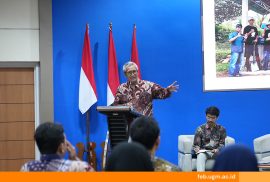
The domestic digital payment system, Quick Response Code Indonesia Standard (QRIS), is in the public spotlight. This time, it is not because of the convenience offered but criticism from the United States (US) government, which considers the implementation of QRIS to limit the space for global industry players. This criticism was contained in the National Trade Estimate (NTE) report released by the Office of the US Trade Representative (USTR) at the end of March 2025.
The following are excerpts from an interview with a Lecturer at the Department of Management, Faculty of Economics and Business, Universitas Gadjah Mada (FEB UGM), Nofie Iman Vidya Kemal, S.E., M.Sc., Ph.D., who studies Technology Management and Innovation Studies on Wednesday, April 23, 2025, related to this QRIS polemic.
How do you see the US criticism of Indonesia’s digital payment system policy, especially QRIS and GPN, as trade barriers?
Recent government policies may offer little to celebrate, but the implementation of QRIS and GPN deserves recognition and praise. QRIS and GPN are forms of resilience and sovereignty in the economic field. The logic is simple: buyers and sellers in Indonesia, goods in Indonesia, transactions using rupiah, why should payment gateway and settlement go abroad?
GPN may “only” expand to match the number of Indonesians, but QRIS, as a payment gateway and settlement mechanism, holds greater potential for broader expansion. Other countries share a common interest in de-dollarization, making QRIS increasingly relevant globally. Singapore has SGQR and PayNow, DuitNow in Malaysia, Vietnam has VietQR, Thai QR and PromptPay in Thailand, and so on.
Suppose this opportunity is captured by all ASEAN countries, given the size of the market and the number of users. In that case, the use of QRIS can be even more widespread, including in South Korea, Japan, China, and the UAE. These conditions will significantly reduce transactions via USD, and our dependence on USD will also decrease. This will create a tremendous snowball effect and a significant blow to MasterCard/VISA.
In the BI RDG press conference in October 2024, QRIS users reached 54.1 million with 34.7 million merchants. Electronic money transactions increased by 27.0 percent (Year on Year / YoY) to 1,365.4 million. Still, ATM or debit cards were only 558.8 million transactions, down 11.4 percent (YoY). So, there is a shift from ATM or debit card transactions (some of which use MasterCard/VISA) to QRIS.
However, the trade barrier between the US and Indonesia is not GPN/QRIS. The barriers lie in other factors such as legal uncertainty, illegal fees, corruption, copyright infringement/piracy, etc. The US criticism of QRIS/GPN is more due to (1) the reduced share of MasterCard/VISA profits, (2) the inability to access/analyze transaction data (market intelligence), and (3) the threat to USD dominance.
This is evident in the US criticism of Indonesia and other countries with independent payment/settlement systems, such as Thailand, Vietnam, India, and Mexico. In short, this is a far-fetched criticism. It is a form of economic coercion. And if the US feels “disturbed,” we may be on the “right track.
So what should the Indonesian government do about this US criticism?
First, don’t be too reactive and overreact to this issue. First, the USTR report on foreign trade barriers has been published for many years, highlighting many complaints and concerns that our government has consistently failed to address or improve meaningfully. Second, these criticisms have some merit. For example, the ticket machines at the Soetta Airport train station only offer QRIS payment options. This is certainly inconvenient for foreigners who don’t have a QRIS.
In addition, when it comes to GPN and QRIS, banks in Indonesia still predominantly offer VISA and MasterCard as payment gateway options. GPN, however, is specifically designed to function as a national system, serving domestic transactions only. Cross-border QRIS is also currently limited to Malaysia, Singapore, and Thailand. This arrangement should still be fair and a valid point of negotiation. This is also in the spirit of the free market that the US promotes: provide choices and let consumers choose.
No one is prohibiting US companies/organizations/citizens from using QRIS. MasterCard/VISA can also develop an API/interface or global protocol to connect to our GPN. You can also work with local partners and then join the GPN network. MasterCard/VISA should not be excluded or given privileges over others.
President Prabowo said that we are a great country, an Asian tiger. It is time to prove that his speech is not just platitudes. Not just yes, man, yes, sir. Let’s not just be bluffed into surrendering. Let’s hope that the ministers and negotiators sent by the president can negotiate all this.
How do QRIS and GPN benefit Indonesians, especially regarding financial inclusion and transaction efficiency?
QRIS is a frugal innovation. It’s a simple innovation; it only requires a mobile phone, which our society already has, but it has a broad and disruptive impact. The impact is evident—Indonesian society is rapidly transitioning to a cashless economy, and this shift is happening at an impressive pace. According to the Indonesian Payment System Association (ASPI), in 2020, QRIS transactions will be only 124 million with a nominal value of Rp8.2 trillion; in 2024, it will be 6.24 billion transactions with Rp695.9 trillion.
Fried food sellers, chicken porridge sellers, market vendors, water/angering even in faq boxes in mosques (inclusivity) can accept cashless payments without having to pay (affordability) for point-of-sale (PoS) machines, electronic data capture (EDC), chip-based cards, and others. Payments are now made using mobile phones alone, eliminating the need for new infrastructure (Adaptability). When combined with inclusivity and affordability, this creates a model of frugal innovation.
The simplicity of QRIS highlights its purpose—to promote financial inclusion. From the user’s perspective, when we pay at a warung, we pay only the nominal bill with no additional fees. There are no administrative or top-up fees, except for specific policies of digital wallet providers or interbank transfers. On the merchant side, transaction fees are 0.3-0.7% per transaction (depending on bank/e-wallet policy). A transaction of Rp 100,000 will cost Rp 300-700. BI encourages the lowest possible fees, even 0%, for micro businesses. There is no fee for registering QRIS or printing QR codes. Fees apply only when merchants opt for additional services, such as a digital POS system.
Compared to VISA/MasterCard. Users are not charged for regular domestic transactions but may be charged 1-3% of the transaction if the card is used abroad or the transaction is in a foreign currency. Annual card fees range from 0 rupiah for basic cards to millions for premium cards. Cash withdrawals from ATMs can cost 2-5% of the withdrawal amount. Merchants charge a transaction fee of 1.5-3.5% per transaction for credit cards and 0.5-1.5% for debit cards, depending on the country and type of transaction. A credit card transaction of Rp 100,000 will cost Rp 1,500-3,500. There are still additional costs such as EDC machine rental/setup, which is Rp 50,000-200,000 per month, cross-border, or an extra 1-2% when receiving payments from foreign cards, and interchange fees paid to the card issuing bank (included in the transaction costs above).
According to some vendors, the time to receive funds via QRIS is faster. Some banks offer both same-day settlement and settlement up to 3-4 times daily. Suppose the merchant’s bank account differs from the QRIS provider’s. If the transaction occurs on a holiday or there are verification issues/technical errors, it may take 1-2 days to process.
This is still better than receiving funds from VISA/MasterCard, which can take 1-3 business days under standard conditions. The time required for international transactions or those requiring currency conversion and interbank networks may take 3-7 business days.
How does this domestic payment system support digital economic growth and MSME empowerment in Indonesia?
The most significant impact of QRIS is its universal nature, i.e., 1 QR code for all banks/merchants, which drives demand-side adoption and adaptation, especially for MSMEs with low or even zero cost, which drives supply-side adoption. QRIS also gained momentum because it coincided with the COVID-19 pandemic – we need a secure contactless solution and reduce the use of cash. So, QRIS exploded in the number of users. The onboarding process to QRIS is very smooth.
While QRIS/GPN does not directly contribute to the digital economy, it helps accelerate digital transformation, especially for MSMEs. Low integration costs allow MSMEs to transform faster. In addition, the shift to domestic switching helps reduce operational costs for financial service providers, allowing them to offer more competitive transaction rates to consumers. This improves the overall efficiency of the national digital economy.
How can this policy protect national interests under the pressure of globalization and the dominance of multinational corporations?
In the concept of digital sovereignty, it is the right of a country to control its data flows and digital infrastructure for the sake of security, sovereignty, and national economic growth. Before GPN, domestic transactions were often routed through international networks like SWIFT, MasterCard, or VISA, which imposed high merchant discount rates (MDR) and stored sensitive data on foreign servers. With their vast size and global capital, multinational companies in the payment sector can influence domestic policies through lobbying and market pressure, thus reducing our country’s room to regulate tariffs and data security.
Through PBI No. 19/8/2017, Bank Indonesia requires NPG switching institutions to be locally licensed and limits foreign ownership to 20% to maintain transparency and accountability in managing the domestic payments infrastructure. All QRIS providers are required to implement national standards. This automatically unifies the ecosystem and reduces integration costs for local merchants and fintechs. The interoperability of GPN and QRIS, which only requires a QR sticker at the merchant, increases cost efficiency and access for MSMEs without relying on imported EDCs. Again, this is in line with the principle of digital sovereignty.
How should Indonesia balance openness to international players and protection of national interests in the digital payments sector? How do we balance innovation with regulation and strategic recommendations to the government?
In Dutch there is a saying “Het recht hink achter de feiten aan”. The law always lags behind the events it regulates. Regarding technology, it is impossible for rules on cryptocurrencies, for example, to appear before innovation. It has to come later. The question is, how big is the gap?
Bank Indonesia has a blueprint for payment systems in Indonesia 2025. OJK released a blueprint for digital banking transformation. The Ministry of Communication and Information first published the vision of digital Indonesia in 2045. As far as I know, we don’t have a comprehensive roadmap for developing the digital economy. However, we remain stuck in fragmented silos that lack integration and sometimes overlap. This is our leading homework: to create a roadmap that is truly comprehensive and integrated but also concretely implemented, not just a formality or administration.
On a technical level, we need a regulatory framework, especially for digital payments, that is more adaptable, forward-looking, measurable, and based on the principle of reciprocity. To address this, the government must establish a comprehensive regulatory sandbox to test innovations before their broad rollout. While BI and OJK currently manage this, it should eventually extend to other sectors. Introducing a tiered licensing mechanism or enforcing a 20% foreign ownership cap will help ensure strategic control stays in national hands.
The state must play an active role in safeguarding national interests and guaranteeing fair and equitable resource distribution. Innovations and regulations must not increase inequality. The state must also have the courage to stand up to digital colonialism. We are vulnerable to coercive pressure from the US on our own, but it’s a different story when we join hands with other countries, especially in the Southeast Asian region.
Report by: Kurnia Ekaptiningrum
Sustainable Development Goals












